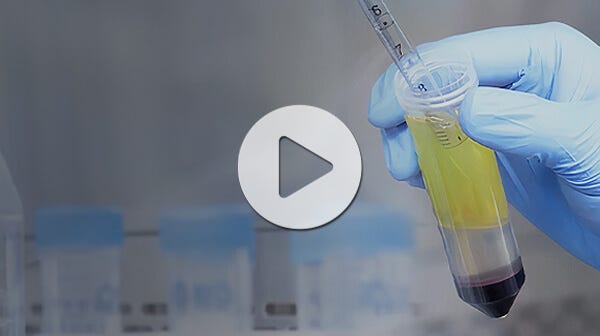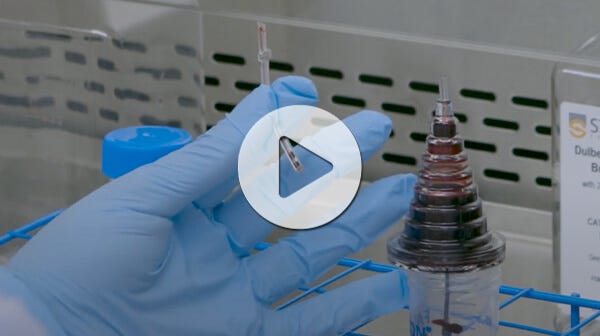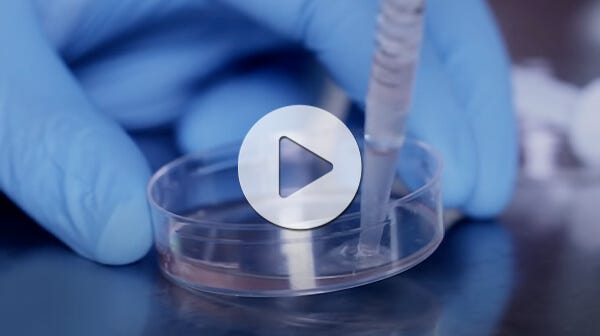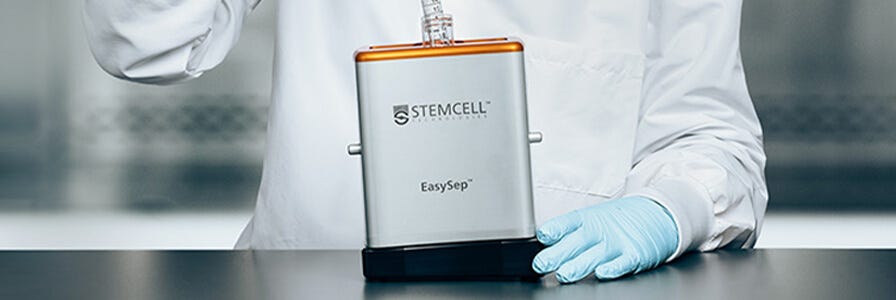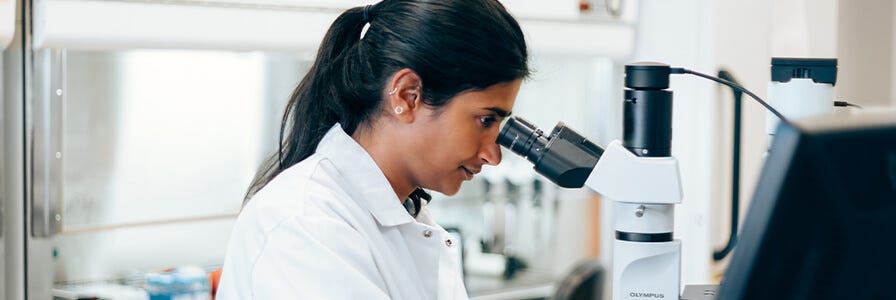EasySep™ Cell Isolation Starting Guide: Tips & Tricks
Achieving high purity and recovery in your cell isolation is essential for accurate assessment of your cell subtype(s) of interest and for ensuring success in your downstream applications. Additionally, throughput, speed, ease-of-use, and automation are all important variables to consider for maximizing the efficiency of your cell isolation. Due to its speed and simplicity, magnetic cell separation is one of the most commonly used methods to isolate highly purified populations of specific cell subsets by targeting cells for selection or depletion using antibodies or ligands directed against specific cell surface antigens.
EasySep™ cell separation technology combines the specificity of monoclonal antibodies with the simplicity of a column-free magnetic system—for fast and easy isolation of highly purified cells that are ready for downstream applications. In this tech tip, we will guide you through key considerations and important steps to get familiar with EasySep™ cell isolation products. Understanding and being aware of these key considerations and tips will help you ensure successful cell isolation.
EasySep™ Kit Storage & Shelf Life
How to Store Your EasySep™ Kit Components
It is important to follow the storage instructions included with your EasySep™ kit to ensure the reagents perform as expected.
- Check the storage instructions of the products upon receipt. Review the "Component Descriptions" table on the Product Information Sheet (PIS) of your specific kit to confirm the recommended storage of each individual component. You can find the PIS for your product here.
- Most EasySep™ kit components should be stored at 2 - 8°C; however, exceptions may apply. For instance, the EasySep™ RBC Lysis Buffer (Catalog #20110), found in some human whole blood positive selection kits, should be stored at 15 - 25°C.
- Use a cold room or fridge to store products at 2 - 8°C. If the product is stored in a fridge, it should be placed either inside of a drawer, or in the middle of the fridge where it is protected from temperature fluctuations. Do not place the kit toward the back or close to the wall of the fridge as this may lead to accidental freezing, which can compromise the integrity of the reagent(s).
Check Expiration Date
ALWAYS check the expiry date of the product before starting your experiment. Performance of expired kits and/or kit components cannot be guaranteed. If the kit has expired, the product should be discarded and a new kit should be purchased.
Tip: To prevent setbacks in your research, include a step to record reagent expiry dates while planning your experiment and going through your list of needed materials.
Optimize Your Sample Preparation Process
Choosing the Right EasySep™ Kit for My Sample
- The performance of our EasySep™ kits has been optimized for specific types and sources of samples as indicated in the corresponding PIS. For most kits, the performance has been optimized using healthy donors and wild-type animal tissue samples; however, exceptions may apply.
- To ensure the compatibility of a kit with a starting sample, go to the “Sample Preparation” section in the PIS of the kit of interest (see the example below). If a kit is used with a sample type not listed on the PIS, the performance may be suboptimal. In some instances, alternative options or optimization may be available; contact us at techsupport@stemcell.com for any assistance.

Selecting the Right Anticoagulant for Whole Blood Samples
For best performance, some of our cell isolation products require the whole blood samples to be collected in a specific anticoagulant. If this is the case, the appropriate anticoagulant will be mentioned in the “Sample Preparation'' section of the PIS. You can find the PIS for your product here. If the PIS does not mention anticoagulants, you may use any standard anticoagulant, i.e. heparin, EDTA (ethylenediaminetetraacetic acid), or ACD (acid citrate dextrose), when collecting the blood sample.
Isolating Cells from Frozen PBMCs
- When using EasySep™ kits with frozen PBMCs, cell clumping may impact the recovery and purity of the cells of interest. In order to reduce cell clumping, most EasySep™ protocols suggest incubating your cells with DNase I before performing cell isolation. IMPORTANT: Do not use DNase I unless specified in the PIS.
Tip: Use a culture medium or buffer without EDTA for this incubation step. - When using EasySep™ kits to isolate cells from frozen PBMCs, go to the “Sample Preparation'' section in the PIS and review the instructions before performing cell isolation. If the PIS does not mention frozen PBMCs and include instructions, it is not recommended to use frozen PBMCs for this particular kit.
- For more information, refer to the following protocols:
How to Thaw Frozen Primary Cells
Ensure optimal thawing of your frozen primary cells for downstream cell isolation by following this protocol.
How to Reduce Cell Clumping in Single-Cell Suspensions Using DNase I
Learn how to harvest cells from a frozen starting sample and prepare a single cell suspension prior to performing cell isolation.
Preparing a Cell Suspension for Downstream Cell Isolation
Once the sample has been collected, or tissue harvested, you might need to further process the sample before moving onto cell isolation. For instance, you may be interested in isolating PBMCs via density gradient centrifugation, tissue dissociation, sample recovery from a Leukocyte Reduction System Cone, etc. A brief protocol is captured in the “Sample Preparation” section in the PIS. For more details, please review the following protocol videos:
Human Cell Suspensions
Explore these protocol videos to help you prepare single-cell suspensions of human primary cells from whole blood, LRS cones (Catalog #200-0093), and leukopaks (Catalog #70500). You’ll find a written protocol accompanying each video.
Mouse Cell Suspensions
Explore these protocol videos to help you prepare single-cell suspensions from mouse tissues, including spleen, brain, lung, and solid tumor. You’ll find a written protocol accompanying each video.
Determining Cell Counts & Cell Concentration
Counting Viable vs. Total Nucleated Cells (TNCs)
- Researchers generally use Trypan Blue to determine both the number of TNCs and viable cells. However, using Trypan Blue for samples containing red blood cells (RBCs) makes it difficult to distinguish between nucleated cells and RBCs. We recommend using 3% Acetic Acid with Methylene Blue (Catalog #07060) instead, which lyses both red and white blood cell membranes. The remaining nuclei will stain lightly with a blue color. Since mature red blood cells do not have nuclei, this will allow you to exclusively count the white blood cells. For more details on cell counting, please see our protocol and associated video.
- Trypan Blue is recommended for counting viable mammalian cells. Trypan Blue (Catalog #07050) penetrates the cell membrane to enter the cytoplasm of cells with compromised membranes (dead cells), staining them blue. The live cells can then be counted as they will remain unstained.
Assessing Cell Recovery & Preparing Single Cell Suspensions
- Determine the number of TNCs and assess the viability of the starting sample before proceeding with your cell isolation.
- IMPORTANT: To assess cell recovery, the TNCs need to be counted in both the starting sample and isolated fraction. Go to the How to Calculate Recovery & Purity from Cell Isolation Procedures section for more information.
- The TNC count is not only needed to assess the recovery, but also to resuspend the cells at the correct concentration:
- For kits optimized on single cell suspensions, the first step of the protocol is generally to resuspend the cells at a specified cell concentration. As an example, if you start with 75 x 106 nucleated cells and the protocol indicates to resuspend the cells at 1 x 108 cells/mL, the cells should be resuspended in (75 x 106 cells x 1 mL) / (1 x 108 cells) = 0.75 mL.
How to Count Cells with a Hemocytometer
Learn how to perform total nucleated cell counts using 3% Acetic Acid with Methylene Blue, and how to perform viable cell counts by Trypan Blue dye exclusion. Additionally, explore cell counting resources and templates to help streamline your assays!
Choose the Appropriate EasySep™ Magnet for Your Kit
EasySep™ magnets for immunomagnetic cell isolation are available in a range of sizes, providing researchers flexibility to process different sample volumes and cell numbers for downstream applications.
Discover our selection of EasySep™ magnets below:
IMPORTANT: Each EasySep™ cell isolation kit can only be used with the EasySep™ magnet(s) listed on the product page under the “MAGNET COMPATIBILITY” section (see example below). If a magnet is not listed on the product page or PIS of the EasySep™ kit, then that kit doesn’t have a validated protocol to use with that magnet. However, our scientific support team may be able to provide alternatives. For more information, contact techsupport@stemcell.com.

Adjusting Sample Volumes for Your EasySep™ Kit
The minimum and maximum sample volumes that can be processed with each particular magnet will be listed under a table in the PIS of each EasySep™ cell isolation kit (see example below).

My Sample Volume Is Larger Than the Magnet’s Recommended Volume
If the cell suspension sample volume is greater than the maximum volume indicated for the magnet you wish to use, go to the PIS and check all the available protocols. A different magnet may have a validated protocol to accommodate your sample volume.
- If the kit is compatible with a magnet suited to process larger sample volumes, we recommend switching to the alternative magnet to make cell isolation more efficient.
- If the kit is not compatible with a magnet suited to process larger volumes, or you don’t have access to one in your lab, you can split the sample in two. However, if you are now working with two samples and one magnet, ensure that the sample is split before adding any reagents. Perform one isolation after the other to prevent prolonged incubation times.
My Sample Volume Is Smaller Than the Magnet’s Recommended Volume
If the cell suspension sample volume is less than the minimum volume indicated for the magnet you wish to use, go to the PIS and check all the available protocols. A different magnet may have a validated protocol to accommodate your sample volume.
- If the kit is compatible with a magnet suited to process smaller volumes, we recommend using the alternative magnet.
- If the kit is not compatible with a magnet suited to process smaller volumes, we suggest topping up the starting sample with the recommended buffer to the minimum volume for the magnet you are currently using as captured in the PIS. IMPORTANT: Be aware that following this approach may affect cell isolation performance.
Critical Steps for Successful Immunomagnetic Cell Isolation with EasySep™
Selecting Cell Separation Buffers & Media
For optimal cell isolation, use one of the buffers captured in the “Recommended Medium” section of the PIS. The recommended medium will typically consist of either EasySep™ Buffer (Catalog #20144) or phosphate buffered saline (PBS) containing 2% fetal bovine serum (FBS) and 1 mM EDTA. Always refer to the PIS for further details.
When Is RBC Lysis Recommended?
RBC lysis may or may not be advised depending on the product of interest. Only perform RBC lysis when indicated in the PIS, otherwise, DO NOT lyse your cells.
- For instance, when working with mouse splenocytes for downstream isolation with EasySep™ cell separation technology, DO NOT use RBC lysis buffer on the cell suspension prior to cell isolation as this may negatively impact cell recovery.
Preparing EasySep™ Reagents Before Use
When using an EasySep™ kit, the vial containing the magnetic particles (e.g. EasySep™ Dextran RapidSpheres™) should be vortexed for 30 seconds before use. The magnetic particles should appear evenly dispersed. IMPORTANT: EasySep™ isolation cocktails should NOT be vortexed.
How to Add & Mix EasySep™ Reagents
- When adding the reagents (e.g. FcR blocker, isolation cocktail, particles, etc.) to your sample, ensure that the end of the pipette tip goes into the liquid. Then, pipette up and down 2 - 3 times to make sure the entire volume has been released.
- When mixing the sample after adding either a reagent or buffer:
- Use either a bigger pipette tip or a serological pipette for volumes > 1 mL to gently pipette up and down 2 - 3 times and mix well. IMPORTANT: This applies to all EasySep™ magnets excluding the Easy 250 EasySep™ Magnet.
- When using the Easy 250 EasySep™ Magnet, alternate between gentle rocking and rotating of the capped flask to minimize sample collection in the flask neck or cap area. IMPORTANT: This only applies to the Easy 250 EasySep™ Magnet (Catalog #100-0821). Watch this step in the "How to Isolate Immune Cells from Large-Volume Samples Using the Easy 250 EasySep™ Magnet" technical video here.
How to Isolate Immune Cells from Large-Volume Samples Using the Easy 250 EasySep™ Magnet
Watch this technical video to learn the key tips and considerations when using the Easy 250 EasySep™ Magnet for your large-scale cell isolations.
Incubating Your Samples with EasySep™
Stick to the incubation times and number of separations described in the PIS of each EasySep™ kit. Deviation from these parameters may lead to suboptimal performance.
Collecting Supernatant from EasySep™ Magnets
EasySep™ magnets for immunomagnetic cell isolation are available in a range of sizes, providing researchers flexibility to process different sample volumes and cell numbers. The process for collecting the supernatant will depend on the specific magnet. Depending on the magnet used, the supernatant is either “poured off” or “pipetted off”. The table below indicates the correct technique to collect the supernatant from each magnet.
How to Collect Supernatant from EasySep™ Magnets
Review this tech tip to learn important considerations and tricks to master supernatant collection from EasySep™ magnets.
How to Calculate Recovery & Purity from Cell Isolation Procedures
Cell isolation performance can be determined through the assessment of cell recovery and purity. To assess performance, you will need to set aside two samples for comparison: (1) starting sample vs. (2) isolated fraction. Briefly, collect one small portion from your starting sample, right before performing cell isolation; and another from your final sample, after isolating your cells. Read the tech tip below to learn how to assess cell isolation performance and measure both cell recovery and purity.
Calculating Purity and Recovery Following Cell Isolation
You should now be ready to start your cell isolation experiment! If you have any questions, contact us at techsupport@stemcell.com.
Request Pricing
Thank you for your interest in this product. Please provide us with your contact information and your local representative will contact you with a customized quote. Where appropriate, they can also assist you with a(n):
Estimated delivery time for your area
Product sample or exclusive offer
In-lab demonstration


